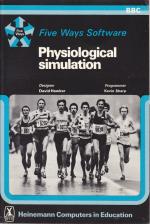
The Micro User
 1st December 1983
1st December 1983
Categories: Review: Software
Author: Peter Hillman
Publisher: Five Ways Software
Machine: BBC Model B
Published in The Micro User 1.10
Investigating what makes you tick
Whatever activity we are involved in, be it sitting and reading The Micro User or competing in a quadrathon, our brains make sure that the body processes are maintained between fine limits.
This system of feedback, or homeos tasis, involving the body organs and the brain is essential to life. At last there is a software package designed to demons trate this vital physiology in a form intelligible to all biology students.
Physiological Simulation is an MEP subsidised biology package published by Heinemann Computers in Education. It is designed for use with pupils aged 13 and above.
The program's greatest asset is that it allows physiological investigations to occur which would not normally be within the scope of school laboratory facilities. It also allows the effect of a simple variable to be assessed in a complex physiological system.
Put simply, the user (playing the part of the brain) has to keep the body, (played by the computer) alive while performing one of a dynamic range of activities, such as running, sleeping, walking, hockey, rock-climbing and rowing.
The user begins by opting to use preset values or to input pupil details (sex, age, mass, blood volume and vital capacity), activities (already mentioned) and parameter values (breath, volume, rate of breathing and sweating rate).
Do not let the idea of measuring pupil blood volumes put you off. The detailed booklet provided has a simple-to-use nomogram which enables this variable to be quickly calculated from the subject's height and mass. Vital capacity is easily measured in class using the normal spirometer apparatus.
Once these data have been provided dynamic graphs show the person's progress over a simulated 50 minute period. A colour monitor is an advantage as the background colour changes from red to blue, while the display remains white.
Apart from a clock showing the time elapsed, graphs of oxygen debt, sugar used, oxygen supply, body temperature and water loss are all provided. A word of warning: the interpretation of the oxygen debt graph needs clear explan ation before the simulation otherwise it is very misleading.
The user must maintain all five of these variables within displayed upper and lower limits or the activity ceases and a message indicates the reason for failure, for example "Person is DEAD"!
The secret of success is to freeze the action when the body is in danger and change either the parameters or activity. Unfortunately the axes of the graphs do not show any scale or units. This facility would make the graphical display more intelligible and bring the software up to A-Level requirements.
Once the simulation has finished it is possible to begin the program again, terminate it or display further options such as beginning a comparative simulation for a second person. After such a comparison the user can replace any one of the two sets of data and try another comparison.
The program is well "studentproofed". It is very difficult to make an error which throws the program haywire.
Clearly such a package is of most use in a teacher demonstration situation - maybe using more than one monitor if the group is large - or possibly by the more able pupil in small well-supervised groups.
Hard copy is not provided for users. This is a pity as a printout would provide a permanent study/revision piece.
A program is only as good as the mathematical model it is based on. The medical data used was mainly derived from a Swiss sample taken in 1956-57.
One cannot help but wonder how different the pupils are today when compared with those used for the present values, but the program's saving grace is that it does allow fresh data to be inserted. The source of the calculations used to plot the graphs is not disclosed - a glaring omission.
The notes for teachers are well documented on the whole and particularly useful for teachers using computer-aided learning material for the first time. It is unfortunate that no bibliography is provided to aid teachers in background/further reading.
Visual presentation in this software package is top class. The program is fun to use, but be prepared to spend an hour or two in preparation time to master its principles first. It is not an instant lesson, nor is it designed to be one, but it is a flexible and powerful educational tool which should be in every biology teacher's "toolbox".
At £12.50 - for disc or tape - this package is good value for money and recommended for use by all secondary school biologists.



